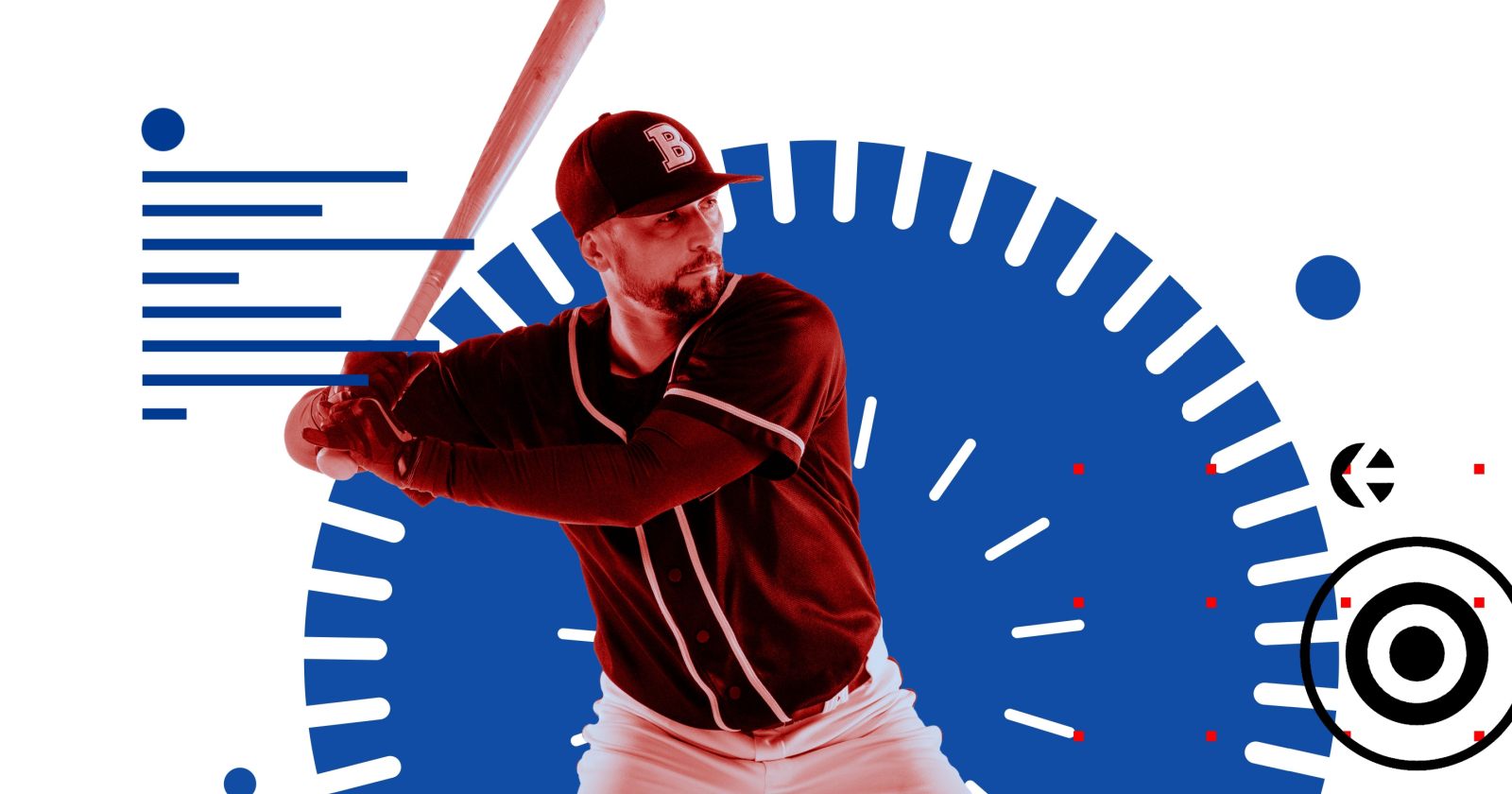On March 29, 2025, the New York Yankees hit a franchise record nine home runs in one game versus the Milwaukee Brewers.
To accomplish this feat, they used a bat that will probably change baseball forever (or not).
They provided Google with the opportunity to oversell its AI abilities, hoping that no one would be familiar with baseball, torpedo bats, and Google Search – all at the same time.
I am that person.
The Background Google Didn’t Tell You
That same day, I was sitting at the very desk I am writing this article on, ordering my groceries online and watching Nestor Cortes pitch against his former team, the New York Yankees.
Cortes, a personal favorite of mine (and of all Yankees fans), picked up right where he left off in 2024 … giving up home runs (he gave a grand slam to the Dodgers in the World Series that I am still hurting from) – dinger (that’s a word for a home run) after dinger.
As I was watching the Yankees crush Cortes (my 7-year-old was on cloud nine), I noticed one of the players’ bats was oddly shaped (that player was Austin Wells, note this for later). I thought it must have been my eyes, but then, player after player, it was the same thing.
The shape of the bat was different. What the Yankees did was custom-load the bulk of the wood of the bat to where the player (per advanced analytics) makes contact most often (so that when they did make contact, it would be harder). Not every player, but a good chunk of the lineup, was using these bats.
You do marketing, not baseball. Why do you care?
Because, as the Yankees hit a franchise record number of home runs in this game, the entire baseball world went bonkers.
Is this bat legal? What is this thing? Who is using it? Since when?
If you are in the baseball world, you know this was an absolutely huge story.
If you’re not familiar with baseball, the term “torpedo bat” sounds entirely obscure and obtuse, which is what Google was counting on when it used this example at Google I/O 2025 to show how advanced its AI abilities are.
What Did Google Say Exactly?
Rajan Patel, who is the VP of Search Engineering at Google, got on stage at Google I/O and said he was a huge baseball fan.
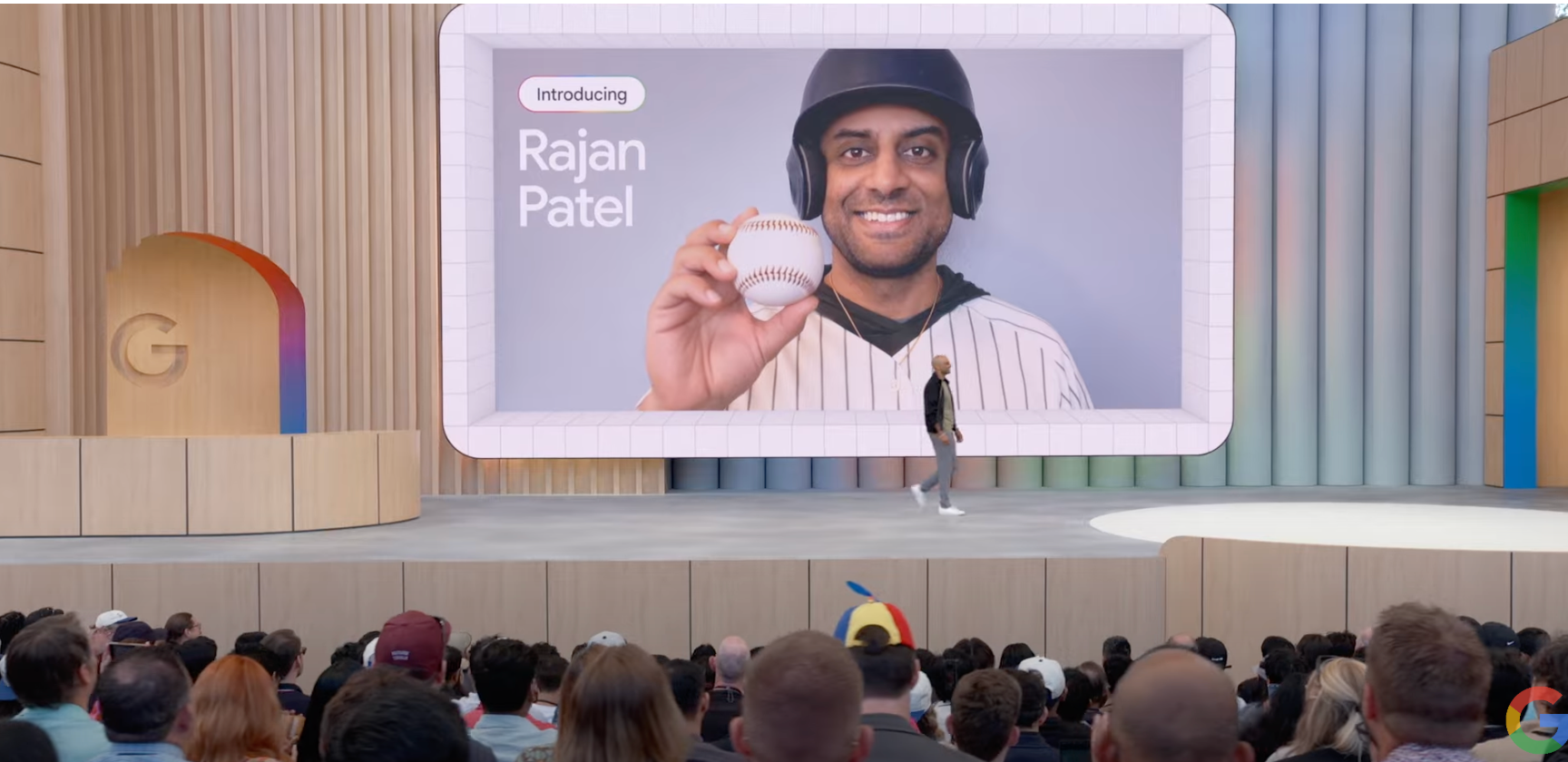 Screenshot from Google I/O 2025 livestream, May 2025
Screenshot from Google I/O 2025 livestream, May 2025So what?
Rajan used a query related to baseball to show how Google’s AI Mode was analyzing complex data.
Specifically, he ran the following query (prompt?): “Show the batting average and OBP for this season and last for notable players who currently use a torpedo bat.”
It seems really complex, which is exactly how Rajan packaged this to the audience, saying: “Think about it, there are so many parts to that question.”
It does seem like a really niche sort of topic that you’d have to have very specific knowledge about.
It’s got multiple layers to it. It’s got data and acronyms wrapped up in it. It’s got everything you need to think that this is a seriously complex question that only advanced AI could answer. It’s even asking for two years’ worth of data.
The reality is that you could find this information out in three very easy searches and never even have to click on a website to do it.
Shall we?
Why What Google Said Is Not ‘Advanced’
This whole “torpedo bats” thing seems extremely niche, which is, again, from an optics and perception point of view, this is exactly what Google wants you to think.
In reality, as I mentioned, this was a hot story in baseball for a good while.
Moreover, the question of who uses these bats was a big deal. People thought, initially, that these players were cheating.
It was a semi-scandal, which means there is a ton of content from big-name websites that specifically lists which players are using the type of bat.
Here you go, it’s right in the featured snippet:
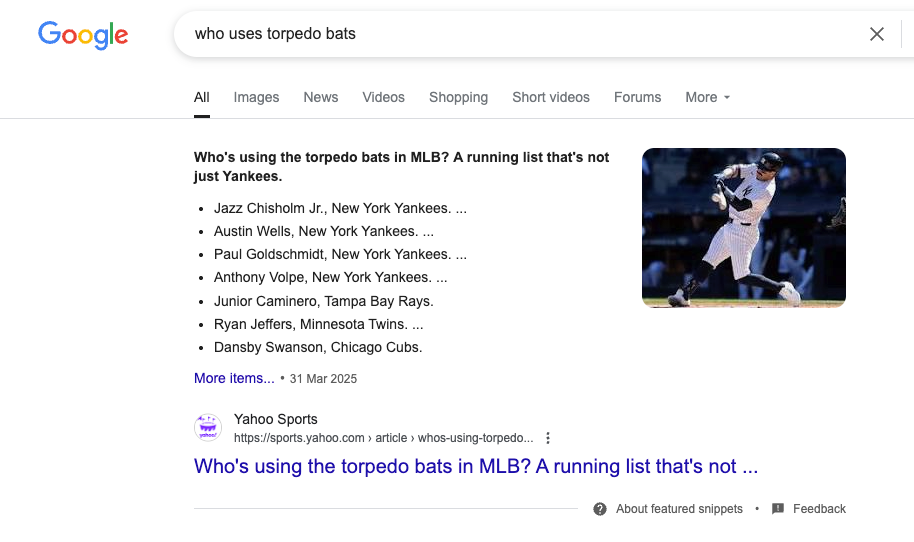 Screenshot from search for [who uses torpedo bats], Google, May 2025
Screenshot from search for [who uses torpedo bats], Google, May 2025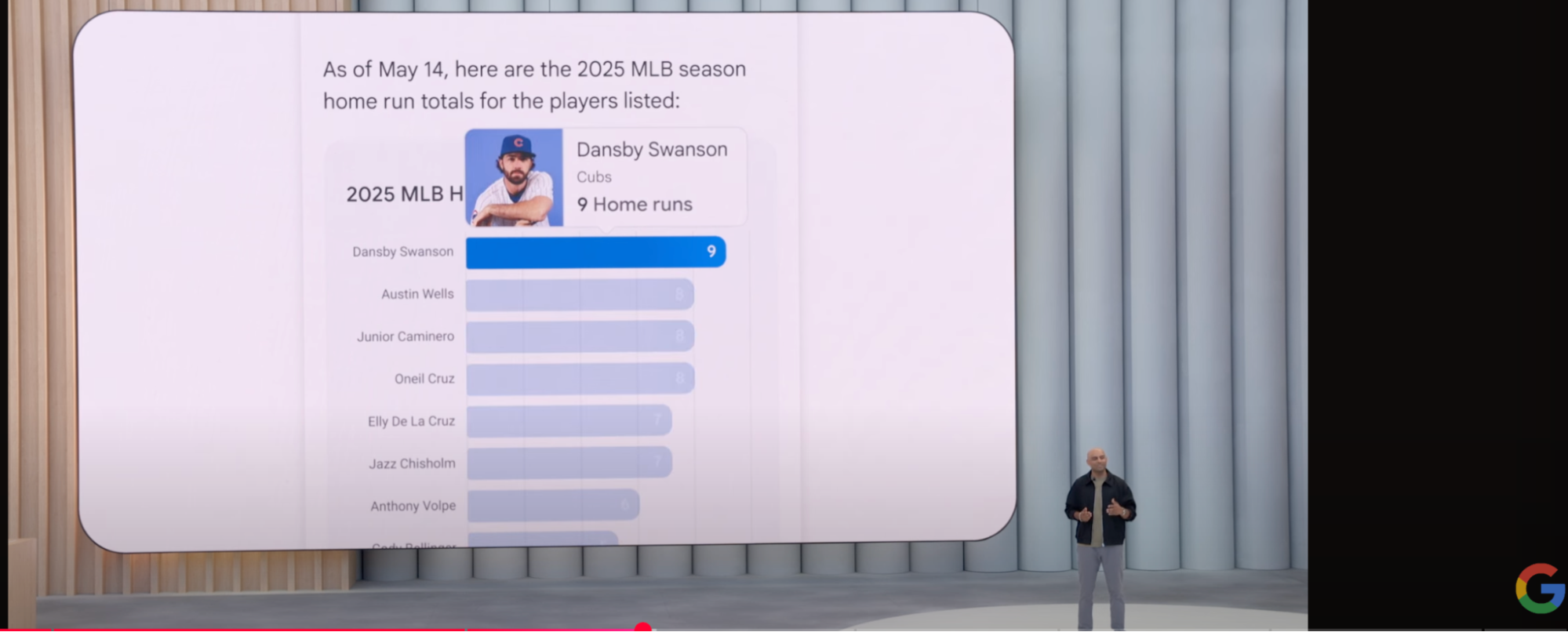 Screenshot from Google I/O 2025 livestream, May 2025
Screenshot from Google I/O 2025 livestream, May 2025Compare the list Google shows to the one from Yahoo Sports.
Four out of the seven on Google lists are right there in the featured snippet (Austin Wells, Jazz Chisolm [Jr.], Anthony Volpe, and Dansby Swanson).
For the record, three out of those four play for the Yankees, and Wells was the first person we saw use the bat type in 2025 (some players experimented using it in 2024).
Not hard information to access. It’s right there – so are the players who are “notable.”
Rajan makes a point of saying Google needs to know who the notable players are to answer this “complex” question. Meaning, he portrayed this as being “complex.”
Maybe in 2015, not in 2025.
It’s been stored in the Knowledge Graph for years.
Just Google [best mlb players]:
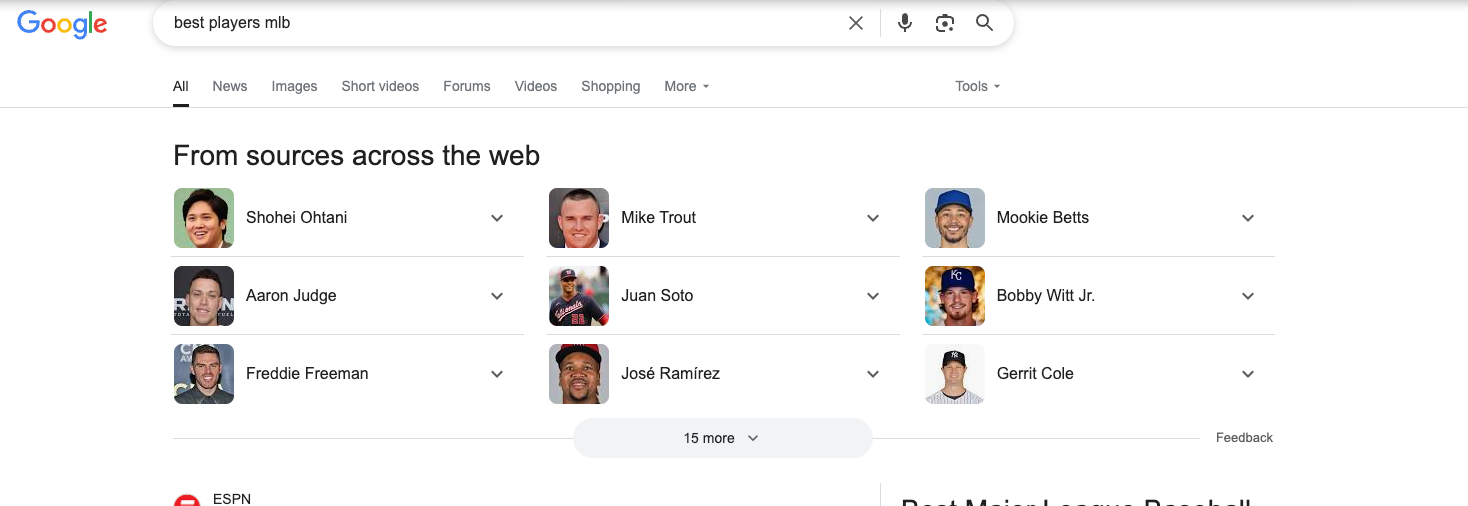 Screenshot from search for [best players mlb], Google, May 2025
Screenshot from search for [best players mlb], Google, May 2025So, the complex thing that Google’s AI Mode had to do was pull information from a Yahoo Sports page (or wherever) and combine that with information it’s been using in the Knowledge Graph for years?
If that’s hard for Google and complex for AI, then we have problems.
There were, in essence, three parts to Google’s “query” here:
- Answering who in the league uses a torpedo bat.
- Identifying notable current players.
- Pulling the stats (this year’s and last year’s) of these notable players using this new bat.
The data part seems complex. Stats? Current stats? Seems like a lot.
There are two things you need to know:
The first thing is that baseball is famous for its stats. Fans and teams have been tracking stats for 100 years – number of home runs, batting averages, earned run averages, runs batted in, strikeout walks, doubles, and triples (we haven’t even gotten into spin rates and launch angles).
That’s correct, baseball teams track how many times the ball spun between when the pitcher threw the ball and when the catcher caught the ball.
Today, the league is dominated by advanced analytics.
Guess who powers it all?
I bet you guessed, Google.
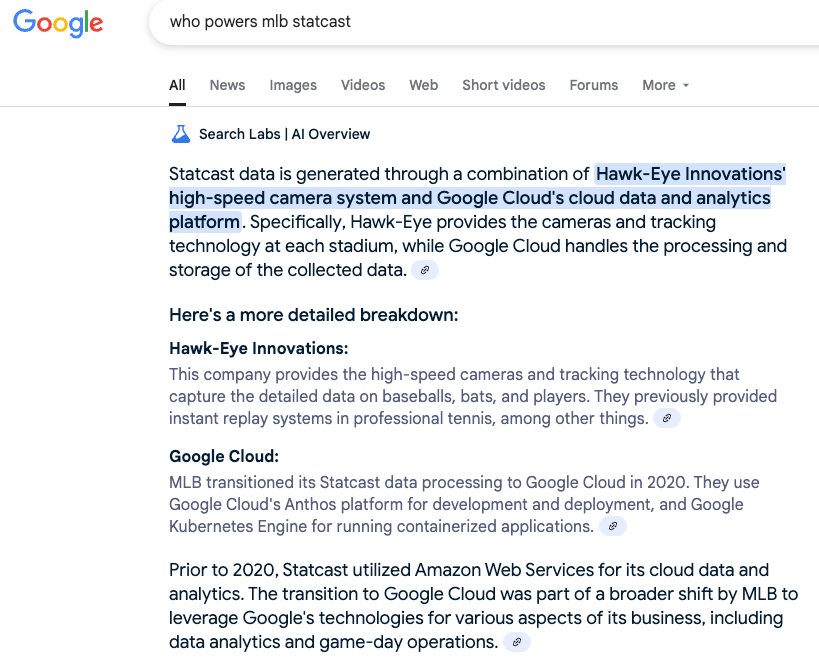 Screenshot from search for [who powers mlb statcast], Google, May 2025
Screenshot from search for [who powers mlb statcast], Google, May 2025Forget that the stats on specific players can be found on dozens upon dozens of websites; Google itself collects them.
Here’s a search for the league’s best player (no, he does not use a torpedo bat):
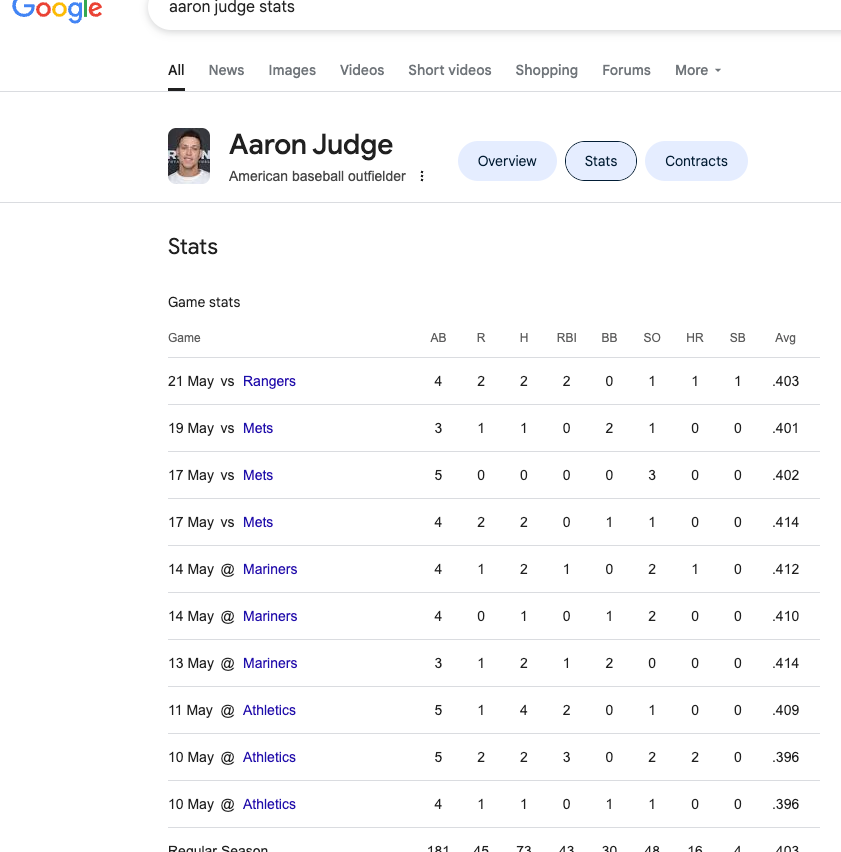 Screenshot from search for [aaron judge stats], Google, May 2025
Screenshot from search for [aaron judge stats], Google, May 2025It’s information that might seem incredibly vast or complex, but it’s literally stored by Google.
What I’m saying is, Google created a “complex” scenario that was nothing more than combining two things it stores in the Knowledge Graph with one thing that is spread all over the web (i.e., the list of players using this type of bat).
Is that really that complex for Google, or was it engineered to look complex for the optics?
What Is The Best Way To Talk About AI Products?
I love the graphs. Taking the data and the information and creating a custom graph with AI?
Love that. That’s amazing. That’s so useful.
Google, you don’t need to oversell it; it’s awesome without you doing that.
Google is not going to listen to me (it will read this article, but it will not listen to my advice). I’m not writing this for Google.
I am writing this for you. If you are a small or a medium-sized marketing team and you’re looking at how Google and other big brands market their AI products as a beacon for your own marketing … don’t.
Don’t feel you have to. Decide on your own what is the best way to talk about AI products.
Is the best way really to overstate the complexity? To try to “package” something as more than it really is?
I get the temptation, but people are not stupid. They will start to see through the smoke and mirrors.
It may take them time. It may take them more time than you might think – but it will happen.
I’ll end with a personal story.
My wife is a nurse. She was recently sent to a seminar where they talked about “what’s happening with all the AI stuff.”
My wife came home and was taken aback by what’s going on out there and how people are using AI, as well as how good the AI was (or wasn’t).
My wife is now a thousand times more skeptical about AI.
What happens if you’re following what these brands are doing and oversell AI when your target audience eventually has the experience my wife did?
More Resources:
- Extending Your Schema Markup From Rich Results To A Knowledge Graph
- Unlocking The Power Of LLM And Knowledge Graph (An Introduction)
- SEO In The Age Of AI
Featured Image: Master1305/Shutterstock

